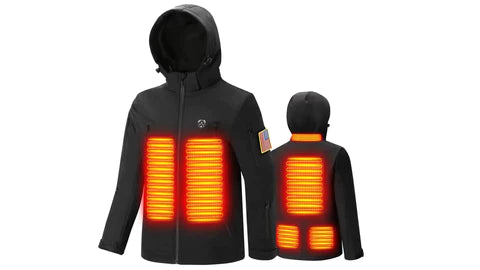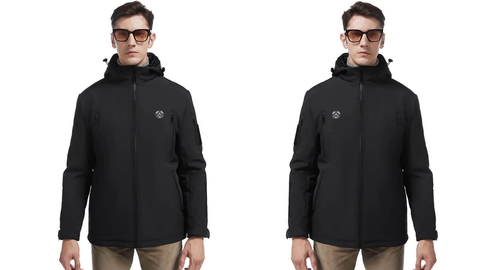A heated jacket is a great way to make yourself ready to enjoy the outdoors irrespective of the chilly temperatures. The primary purpose of a heated jacket is to provide warmth and comfort in cold weather conditions. By selecting the right jacket, you can ensure that you stay cozy and comfortable, allowing you to enjoy your outdoor activities without being hindered by the cold.
In this article, you’ll go through a guide, so that you can choose the most befitting heated jacket that matches your needs.
Assessing Your Needs
Where’s Your Heated Jacket Useful?
1. Winter Sports
Heated jackets are popular among skiers, snowboarders, ice climbers, and snowshoers. These activities often involve prolonged exposure to cold temperatures, and a heated jacket can provide essential warmth and comfort.
2. Hiking and Camping
Heated jackets are valuable for hiking and camping trips, especially during colder seasons. They help keep you warm during chilly mornings, evenings, or when camping at higher elevations.
3. Hunting and Fishing
Heated jackets can be beneficial for hunters and anglers who spend long hours outdoors in cold conditions. They provide warmth, allowing you to stay comfortable and focused on your activity.


Self Assessment & Why It’s Crucial?
You should consider your requirements, taste, and preferences, before you make a purchase when it comes to heated jackets. These are specialized jackets, which have mind-blowing technology built inside them.
Keeping yourself warm is crucial but not everyone needs the same amount of heat and warmth. Due to different cold tolerance levels, physical strength, stamina, and uses, the choice of heated jacket can differ.
Understanding Heating Technologies
Carbon Fiber Heating
This technology involves thin and flexible carbon fiber heating elements embedded within the jacket's fabric. Carbon fiber heating panels can generate heat when an electric current passes through them. They are lightweight, durable, and provide even heat distribution.
Advantages:
- Carbon fiber heating elements are designed to provide even heat distribution throughout the jacket, ensuring consistent warmth.
- Carbon fiber heating panels are thin, lightweight, and flexible, allowing for greater freedom of movement and comfort.
- Carbon fiber heating elements are generally durable and can withstand bending and stretching without compromising their functionality.
Disadvantages:
- Carbon fiber heating elements may take a bit longer to reach their maximum heating capacity compared to other technologies.
- Carbon fiber heating panels may provide a milder heat compared to other technologies, which may be a drawback for individuals who prefer intense warmth.
Battery Performance:
Carbon fiber heating typically requires less power, resulting in potentially longer battery life compared to other heating technologies.
Micro-Heating Wires
Micro-heating wires are fine, electrically conductive wires integrated into the fabric or lining of the jacket. When powered, these wires produce heat, providing warmth throughout the jacket. Micro-heating wires are often discreet and flexible, ensuring comfort and targeted heating.
Advantages:
- Micro-heating wires can generate heat rapidly, providing almost immediate warmth upon activation.
- It has the potential to generate higher levels of heat compared to other technologies, offering a more intense warmth.
- The placement of micro-heating wires can be strategically designed to provide focused warmth in specific areas, such as the chest or back.
Disadvantages:
- Depending on the design and placement of the micro-heating wires, the heat distribution may be less uniform compared to other technologies.
- Micro-heating wires, due to their thicker construction, may add a bit of bulk to the jacket compared to jackets with other heating technologies.
Battery Performance:
Micro-heating wires typically require more power to generate heat, which may result in slightly shorter battery life compared to jackets with carbon fiber heating.


Heating Element Placement In Heated Jackets
Primary Heating Areas:
Core Body Areas: Heating elements are typically placed in the core body areas, such as the chest, back, and sometimes the upper abdomen. These areas are crucial for generating warmth and maintaining overall body temperature.
Secondary Heating Areas:
- Collar and Neck: Some jackets have heating elements integrated into the collar or neck area to provide additional warmth and comfort to the sensitive neck region.
- Shoulders and Upper Back: Heating elements may be placed in the shoulders and upper back region to target these areas, which are prone to experiencing muscle tension and discomfort in colder conditions.
- Lower Back and Kidney Area: The lower back and kidney area often have heating elements to provide warmth and support to this vital part of the body, helping to maintain core body temperature.
Optional Heating Areas:
- Sleeves and Cuffs: In certain heated jackets, heating elements are positioned along the sleeves and cuffs to provide warmth to the arms and wrists. This can be particularly beneficial in activities that require dexterity and mobility of the hands.
- Pockets: Some jackets have heating elements integrated into specific pockets, allowing for warming of the hands or providing additional warmth to items placed in those pockets.
Key Features To Consider In Heated Jackets
Insulation & Material
Look for a heated jacket with effective insulation to trap and retain heat. Quality insulation materials, such as down or synthetic fibers like polyester or PrimaLoft, help keep you warm by preventing heat loss.
Choose a heated jacket made from durable, weather-resistant materials. Common options include nylon, polyester, or softshell fabrics. Ensure that the material is both breathable and capable of withstanding outdoor conditions.
Battery Life & Heating Settings
Consider the battery life of the jacket, as it determines how long the heat will last. Longer battery life allows for extended use without the need for frequent recharging. Look for jackets with sufficient battery capacity for your intended activities.
Check the available heat settings and controls. Look for jackets that offer adjustable heat levels to customize your comfort based on the weather conditions and your activity level. Multiple heat settings allow you to find the right balance between warmth and energy efficiency.
Fit & Comfort
Ensure the heated jacket fits well and offers freedom of movement. Look for jackets with a comfortable and adjustable fit that accommodates layering without being overly bulky or restrictive. Consider your body shape and the intended use of the jacket when assessing its fit.
Durability & Weather Resistance
Durable materials and construction are crucial factors in ensuring the long-lasting performance of heated jackets. Heated jackets constructed with durable materials are more likely to withstand the rigors of outdoor use over an extended period. Robust materials and construction techniques enhance the jacket's overall lifespan, allowing you to enjoy its warmth and functionality for years to come.
Water Resistance & Windproof: Heated jackets with durable materials and weather-resistant features provide better protection against wind, rain, and snow. These elements can degrade the performance of lesser-quality jackets or cause damage. Durability ensures the jacket remains reliable in adverse weather conditions.
Additional Features: The construction of a heated jacket should include provisions for protecting the heating elements. Durable materials and thoughtful construction techniques prevent the heating elements from being damaged or compromised during regular wear or accidental impacts.
Safety Considerations
Overheat Protection: Overheat protection mechanisms are designed to prevent the jacket from reaching excessively high temperatures. These safety features typically involve automatic temperature regulation or sensors that monitor the heat output. If the jacket's temperature exceeds a certain threshold, the heating elements are automatically adjusted or deactivated to prevent overheating.
Timed Auto-Shutoff: Some heated jackets have a timed auto-shutoff feature, which automatically turns off the heating elements after a certain period of continuous operation. This feature helps conserve battery life and reduces the risk of excessive heat exposure if the jacket is inadvertently left on.
CE Marking: The CE marking is a conformity mark indicating that the product meets the requirements of European safety, health, and environmental protection standards. Heated jackets with the CE mark comply with applicable European Union regulations.
UL Certification: UL is a global safety science company that provides certifications for various products. UL certification ensures that a heated jacket meets specific safety standards and requirements, including electrical safety.


Researching & Comparing Options
Some Useful Tips:
- Consider the intended use, desired heat levels, battery life, fit, and any additional features you may require.
- Conduct thorough research on reputable brands that offer heated jackets.
- Read customer reviews, check product descriptions, and compare features to gain insights into the quality, performance, and reliability of different models.
Reputed Brands For Heated Jackets
- The North Face: The North Face is a well-respected outdoor apparel brand that offers a range of heated jackets known for their durability, insulation, and functionality.
- Columbia: Columbia is a reputable brand known for its innovative outdoor clothing, including heated jackets. They combine advanced heating technologies with their expertise in outdoor gear to provide reliable warmth and comfort.
- iHood: It’s another heated jacket brand that’s meant for keeping the core and secondary organs heated, while keeping the user fit and comfortable.
Online Resource & Platform To Consider
You can always go to ihood official website and look for the latest heated jackets and other heated wearables like vests, pants, etc.
Conclusion
By the end of this article, we’ve come to a conclusion that heated jackets have a lot of mindblowing features that can keep the body heated throughout the wearing session. There are several features like secondary organs heating, etc. Then you should also consider certifications and go through some useful tips to buy the most appealing jacket for yourself.


